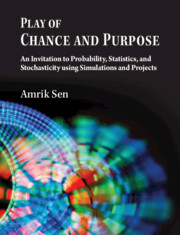Refine search
Actions for selected content:
3044 results in Probability theory and stochastic processes

High-Dimensional Probability
- An Introduction with Applications in Data Science
- Coming soon
-
- Expected online publication date:
- January 2026
- Print publication:
- 31 January 2026
-
- Book
- Export citation

Play of Chance and Purpose
- An Invitation to Probability, Statistics, and Stochasticity Using Simulations and Projects
- Coming soon
-
- Expected online publication date:
- December 2025
- Print publication:
- 31 January 2026
-
- Textbook
- Export citation
6 - Gaussian Free Field with Neumann Boundary Conditions
-
- Book:
- Gaussian Free Field and Liouville Quantum Gravity
- Published online:
- 20 November 2025
- Print publication:
- 04 December 2025, pp 220-255
-
- Chapter
- Export citation
Index
-
- Book:
- Gaussian Free Field and Liouville Quantum Gravity
- Published online:
- 20 November 2025
- Print publication:
- 04 December 2025, pp 414-416
-
- Chapter
- Export citation
5 - Introduction to Liouville Conformal Field Theory
-
- Book:
- Gaussian Free Field and Liouville Quantum Gravity
- Published online:
- 20 November 2025
- Print publication:
- 04 December 2025, pp 168-219
-
- Chapter
- Export citation
1 - Definition and Properties of the GFF
-
- Book:
- Gaussian Free Field and Liouville Quantum Gravity
- Published online:
- 20 November 2025
- Print publication:
- 04 December 2025, pp 1-56
-
- Chapter
-
- You have access
- Export citation
References
-
- Book:
- Gaussian Free Field and Liouville Quantum Gravity
- Published online:
- 20 November 2025
- Print publication:
- 04 December 2025, pp 399-410
-
- Chapter
- Export citation
7 - QuantumWedges and Scale-Invariant Random Surfaces
-
- Book:
- Gaussian Free Field and Liouville Quantum Gravity
- Published online:
- 20 November 2025
- Print publication:
- 04 December 2025, pp 256-298
-
- Chapter
- Export citation
Notation and Symbols
-
- Book:
- Gaussian Free Field and Liouville Quantum Gravity
- Published online:
- 20 November 2025
- Print publication:
- 04 December 2025, pp 411-413
-
- Chapter
- Export citation
Contents
-
- Book:
- Gaussian Free Field and Liouville Quantum Gravity
- Published online:
- 20 November 2025
- Print publication:
- 04 December 2025, pp ix-xii
-
- Chapter
- Export citation
Acknowledgements
-
- Book:
- Gaussian Free Field and Liouville Quantum Gravity
- Published online:
- 20 November 2025
- Print publication:
- 04 December 2025, pp xvii-xx
-
- Chapter
- Export citation
4 - Statistical Physics on Random Planar Maps
-
- Book:
- Gaussian Free Field and Liouville Quantum Gravity
- Published online:
- 20 November 2025
- Print publication:
- 04 December 2025, pp 133-167
-
- Chapter
- Export citation
Frontmatter
-
- Book:
- Gaussian Free Field and Liouville Quantum Gravity
- Published online:
- 20 November 2025
- Print publication:
- 04 December 2025, pp i-vi
-
- Chapter
- Export citation
Appendix B - Reverse Loewner Flow and Reverse SLE
-
- Book:
- Gaussian Free Field and Liouville Quantum Gravity
- Published online:
- 20 November 2025
- Print publication:
- 04 December 2025, pp 382-390
-
- Chapter
- Export citation
9 - Liouville Quantum Gravity as a Mating of Trees
-
- Book:
- Gaussian Free Field and Liouville Quantum Gravity
- Published online:
- 20 November 2025
- Print publication:
- 04 December 2025, pp 334-372
-
- Chapter
- Export citation
Preface
-
- Book:
- Gaussian Free Field and Liouville Quantum Gravity
- Published online:
- 20 November 2025
- Print publication:
- 04 December 2025, pp xiii-xvi
-
- Chapter
- Export citation
Dedication
-
- Book:
- Gaussian Free Field and Liouville Quantum Gravity
- Published online:
- 20 November 2025
- Print publication:
- 04 December 2025, pp vii-viii
-
- Chapter
- Export citation
8 - SLE and the Quantum Zipper
-
- Book:
- Gaussian Free Field and Liouville Quantum Gravity
- Published online:
- 20 November 2025
- Print publication:
- 04 December 2025, pp 299-333
-
- Chapter
- Export citation
2 - Liouville Measure
-
- Book:
- Gaussian Free Field and Liouville Quantum Gravity
- Published online:
- 20 November 2025
- Print publication:
- 04 December 2025, pp 57-74
-
- Chapter
- Export citation
Appendix D - Convergence of Random Variables in the Space of Distributions
-
- Book:
- Gaussian Free Field and Liouville Quantum Gravity
- Published online:
- 20 November 2025
- Print publication:
- 04 December 2025, pp 396-398
-
- Chapter
- Export citation
